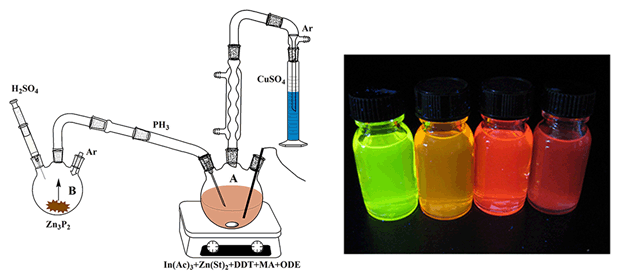| [1] Bera, D.; Qian, L.; Tseng, T. K.; Holloway, P. H. Materials 2010, 3, 2260.
[2] Bourzac, K. Nature 2013, 493, 283.
[3] Zhang, Y.; Xie, C.; Su, H. P.; Liu, J.; Pickering, S.; Wang, Y. Q.; Yu, W. W.; Wang, J. K.; Wang, Y. D.; Hahm, J.; Dellas, N.; Mohney, S. E.; Xu, J. Nano Lett. 2011, 11, 329.
[4] Michalet, X.; Pinaud, F. F.; Bentolila, L. A.; Tsay, J. M.; Doose, S.; Li, J. J.; Sundaresan, G.; Wu, A. M.; Gambhir, S. S.; Weiss, S. Science 2005, 307, 538.
[5] Li, L.; Daou, J.; Texier, I.; Chi, T. T. K.; Liem, N. Q.; Reiss, P. Chem. Mater. 2009, 21, 2422.
[6] Chen, F. Q.; Gerion, D. Nano Lett. 2004, 4, 1827.
[7] Xie, R. G.; Battaglia, D.; Peng, X. G. J. Am. Chem. Soc. 2007, 129, 15432.
[8] Tamang, S.; Lincheneau, C.; Hermans, Y.; Jeong, S.; Reiss, P. Chem. Mater. 2016, 28, 2491.
[9] Adam, S.; Talapin, D.; Borchert, H.; Lobo, A.; McGinley, C.; De Castro, A.; Hasse, M.; Weller, H.; Möller, T. J. Chem. Phys. 2005, 123, 084706.
[10] Lovingood, D. D.; Strouse, G. F. Nano Lett. 2008, 8, 3394.
[11] Li, Q.; Zhang, T.; Gu, H. W.; Ding, F. Z.; Qu, F.; Peng, X. Y.; Wang, H. Y.; Wu, Z. P. Acta Chim. Sinica 2013, 71, 929. (李谦, 张腾, 古宏伟, 丁发柱, 屈飞, 彭星煜, 王洪艳, 吴战鹏, 化学学报, 2013, 71, 929.)
[12] Li, L.; Reiss, P. J. Am. Chem. Soc. 2008, 130, 11588.
[13] Kim, T. H.; Kim, S. W.; Kang, M. J.; Kim, S. W. J. Phys. Chem. Lett. 2012, 3, 214.
[14] Alt?ntas, Y.; Talpur, M. Y.; Ünlu, M.; Mutlugün, E. J. Phys. Chem. C 2016, 120, 7885.
[15] Li, L.; Protière, M.; Reiss, P. Chem. Mater. 2008, 20, 2621.
[16] Zan, F.; Ren, J. C. J. Mater. Chem. 2012, 22, 1794.
[17] Chen, M. H.; Pan, Z.; Yin, Y. F.; Liu, J.; Liu, M. Y.; Jia, Z. J.; Liang, G. J. Acta Chim. Sinica 2016, 74, 330. (陈美华, 潘峥, 尹月锋, 刘洁, 刘梦媛, 贾紫君, 梁桂杰, 化学学报, 2016, 74, 330.)
[18] Xu, S.; Ziegler, J.; Nann, T. J. Mater. Chem. 2008, 18, 2653. |
